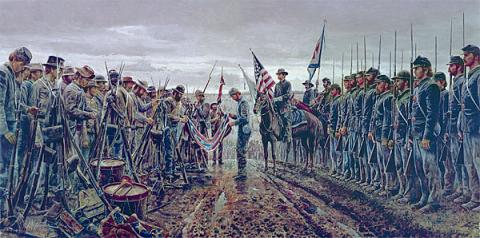
On this day in 1865, three days after General Lee's surrender, and four years to the day after the war began in 1861 with the firing on Fort Sumter, Confederate troops formally surrendered to Union. The work of art above, "Salute of Honor" by Mort Kunstler, is so moving to me. But it's even more profound when we consider what was happening at this moment in history. Kunstler's Web site describes it so poignantly, I'm going to quote from it directly:
They faced each other in two long straight lines - just as they had so many times before on so many bloody fields of fire. This time was different. Three days earlier, General Robert E. Lee had surrendered the skeletal remnants of his hard-fighting Army of Northern Virginia to General Ulysses S. Grant in farmer Wilmer McLean's parlor. Now it was time for the Sons of the South to lay down their arms and give up their bloodied battle flags. As enemies, these men in blue and gray had faced each other at Petersburg and Cold Harbor, at Gettysburg and Chancellorsville, at Fredericksburg and Antietam, at Second Manassas and Malvern Hill. Now they again stood in great ranks opposite each other - one now the victor, the other now the vanquished. Placed in command of receiving the Southern surrender was Brigadier General Joshua Lawrence Chamberlain, a Northern war hero who bore four battle wounds inflicted by these men in gray and butternut now assembled before him. Absent in Chamberlain, however, was any animosity toward these former foes; present instead was a sense of respect for fellow countrymen who had given their all in the grip of war. At Chamberlain's order, there was no jeering. No beating of drums, no chorus of cheers nor other unseemly celebration in the face of a fallen foe. "Before us in proud humiliation," Chamberlain would later recall, "stood the embodiment of manhood: men whom neither toils and sufferings, nor the fact of death, nor disaster, nor hopelessness could bend from their resolve; standing before us now, thin, worn, and famished, but erect, and with eyes looking level into ours, waking memories that bound us together as no other bond. Was not such manhood to be welcomed back into a Union so tested and assured?" At Chamberlain's command, the Northern troops receiving the surrender shifted their weapons to "carry arms" - a soldier's salute, delivered in respect to the defeated Southerners standing before them. Confederate General John B. Gordon, immediately recognized this remarkable, generous gesture offered by fellow Americans - and responded with a like salute. Honor answering honor. Then it was over. And a new day had begun - built on this salute of honor at Appomattox. Former foes both North and South - in mutual respect and mutual toleration - now faced the future together. As Americans all.
That future-- the Reconstruction period-- was anything but smooth sailing. In fact, Reconstruction has even been called the Second Civil War due to the intense struggles Americans faced as they pieced their lives and their country back together. But on April 12, 1865, whether they were heartbroken or joyful, there must have been a shared feeling of sober relief that the carnage of the war was over. *If your fascination with the Civil War has not ended with the close of the 150th anniversary dates, I invite you to browse through thirty (and counting) posts I've written on Civil War history. Find them here.


Add new comment